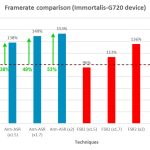ARM has introduced a new upscaling solution for mobile devices. Named Arm ASR (Adaptive Scalable Resolution), this technology aims to tackle a key challenge in mobile gaming – delivering top-notch graphics without draining battery life or causing devices to heat up.
According to ARM, ASR is based on AMD's FidelityFX Super Resolution 2 (FSR 2), but it's tailored specifically for smartphones and tablets. It offers advanced upscaling capabilities that promise to elevate the visual quality of games, improve performance, and consume less power than current solutions like FSR 2.
The core of Arm ASR lies in its use of temporal upscaling, a technique that taps into data from multiple frames to generate high-quality images from lower-resolution inputs. Although more complex than traditional frame-by-frame upscaling, temporal upscaling produces superior results and provides game developers greater flexibility.
Benchmark tests revealed that devices equipped with the Arm Immortalis-G720 GPU experienced substantial framerate improvements compared to native resolution rendering and Qualcomm's Game Super Resolution (GSR). ASR enhances visual fidelity and contributes to maintaining consistent temperatures, thereby mitigating the risk of thermal throttling that can disrupt the gaming experience.
In collaboration with MediaTek, Arm ASR demonstrated significant power savings when deployed on a Dimensity 9300 device, translating to extended battery life for mobile gaming. This addresses a crucial pain point for gamers and highlights the potential for ASR to make a meaningful impact. To encourage widespread adoption and experimentation, Arm has made ASR available under an MIT open-source license.
Discuss on our Facebook page, HERE.
KitGuru says: As the number of upscaling technologies in the mobile market increases, mobile OS developers should start thinking of doing something similar to Microsoft DirectSR to simplify the process for game and app developers.
 KitGuru KitGuru.net – Tech News | Hardware News | Hardware Reviews | IOS | Mobile | Gaming | Graphics Cards
KitGuru KitGuru.net – Tech News | Hardware News | Hardware Reviews | IOS | Mobile | Gaming | Graphics Cards






